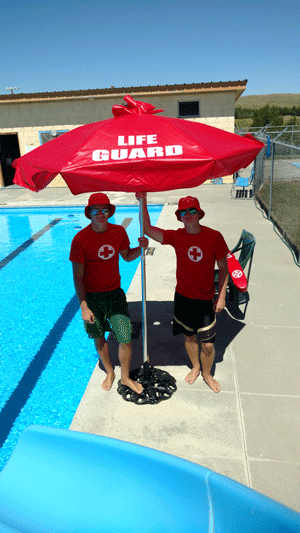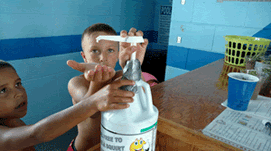 Pool Cool is to increases awareness and sun protection practices among pool staff and patrons. Childhood sunburns can cause skin cancer -- the most common type of cancer in the U.S.and is largely preventable.
Pool Cool is to increases awareness and sun protection practices among pool staff and patrons. Childhood sunburns can cause skin cancer -- the most common type of cancer in the U.S.and is largely preventable.
Everyone can help prevent skin cancer for themselves and their children by minimizing exposure to the sun between 10 a.m. and 4 p.m., seeking shade from the mid-day sun when possible, wearing clothes, hats and sunglasses to protect the skin, using sunscreen with a sun protection factor (SPF) of 30or more and avoiding sunlamps and tanning beds.
Information on Sunscreen:
The sun's UV rays can damage your skin in as little as 15 minutes. Put on sunscreen before you go outside, even on slightly cloudy or cool days. Don't forget to put a thick layer on all parts of exposed skin. Get help for hard-to-reach places like your back.
How sunscreen works. Most sun protection products work by absorbing, reflecting, or scattering sunlight. They contain chemicals that interact with the skin to protect it from UV rays. All products do not have the same ingredients; if your skin reacts badly to one product, try another one or call a doctor.
SPF. Sunscreens are assigned a sun protection factor (SPF) number that rates their effectiveness in blocking UV rays. Higher numbers indicate more protection. You should use a sunscreen with at least SPF 30.
Reapplication. Sunscreen wears off. Put it on again if you stay out in the sun for more than two hours. Reapply every hour if you are swimming or doing things that make you sweat.
Expiration date. Check the sunscreen's expiration date. Sunscreen without an expiration date should be disposed of after one year. It is hard to tell how long the store had it on its shelf. Sunscreen exposed to high temperatures loses its protection so it needs to be kept out of the direct sun.
Cosmetics. Some make-up and lip balms contain some of the same chemicals used in sunscreens. If they do not have at least SPF 30, don't use them by themselves.
Clothing
Loose-fitting long-sleeved shirts and long pants made from tightly woven fabric offer the best protection from the sun's UV rays. A wet T-shirt offers much less UV protection than a dry one. Darker colors may offer more protection than lighter colors.
If wearing this type of clothing isn't practical, at least try to wear a T-shirt or a beach cover-up. Keep in mind that a typical T-shirt has an SPF rating lower than 15, so use other types of protection as well.
Hats
For the most protection, wear a hat with a brim all the way around that shades your face, ears, and the back of your neck. A tightly woven fabric, such as canvas, works best to protect your skin from UV rays. Avoid straw hats with holes that let sunlight through. A darker hat may offer more UV protection.
If you wear a baseball cap, you should also protect your ears and the back of your neck by wearing clothing that covers those areas, using sunscreen with at least SPF 15, or by staying in the shade.
Sunglasses
Sunglasses protect your eyes from UV rays and reduce the risk of cataracts. They also protect the tender skin around your eyes from sun exposure.
Sunglasses that block both UVA and UVB rays offer the best protection. Most sunglasses sold in the United States, regardless of cost, meet this standard. Wrap-around sunglasses work best because they block UV rays from sneaking in from the side.
Shade
You can reduce your risk of skin damage and skin cancer by seeking shade under an umbrella, tree, or other shelter before you need relief from the sun. Your best bet to protect your skin is to use sunscreen or wear protective clothing when you're outside; even when you're in the shade.
Photographs taken at Hyannis Swimming Pool.
References
1Centers for Disease Control and Prevention. Guidelines for school programs to prevent skin cancer. MMWR 2002;51(No. RR-4):1?16.

